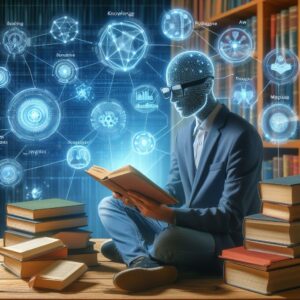The seminal paper “Unifying Large Language Models and Knowledge Graphs: A Roadmap” published on June 14, 2023, presents a comprehensive framework for integrating the emergent capabilities of Large Language Models (LLMs) with the structured knowledge representation of Knowledge Graphs (KGs) Authored by Shirui Pan, Linhao Luo, Yufei Wang, Chen Chen, Jiapu Wang, and Xindong Wu, the paper outlines three general frameworks for this unification: KG-enhanced LLMs, LLM-augmented KGs, and Synergized LLMs + KGs. These frameworks aim to leverage the strengths of both LLMs and KGs to enhance AI’s inferential and interpretative abilities, address the construction and evolution challenges of KGs, and promote bidirectional reasoning driven by data and knowledge. The paper’s roadmap is a forward-looking guide that reviews existing efforts and pinpoints future research directions, marking a pivotal contribution to the field of natural language processing and artificial intelligence.
GraphRAG: A New Frontier for LLMs
- GraphRAG stands as a significant advancement in enhancing the capabilities of LLMs, particularly in the context of private datasets. A recent publication from Microsoft Research titled “GraphRAG: Unlocking LLM discovery on narrative private data” introduces GraphRAG as a method to improve question-and-answer performance when analyzing complex information. The technique uses LLM-generated knowledge graphs alongside graph machine learning to perform prompt augmentation at query time, showing substantial improvements over baseline RAG approaches.
- Another notable work is detailed in the arXiv paper “From Local to Global: A Graph RAG Approach to Query-Focused Summarization”. This paper proposes a Graph RAG approach that scales with the generality of user questions and the quantity of source text to be indexed. It uses an LLM to build a graph-based text index, which then aids in generating comprehensive and diverse answers for global sensemaking questions.
Knowledge Graphs: Enhancing LLM Precision
- Knowledge Graphs serve as a structured representation of knowledge, capturing relationships between entities. They have been increasingly used as context sources for LLMs to provide more precise and relevant outputs. The paper “Knowledge Graphs as Context Sources for LLM-Based Explanations of Learning Recommendations” explores the use of Knowledge Graphs to reduce the risk of model hallucinations and ensure high precision in the context of personalized education.
- Furthermore, the research titled “Knowledge Graph Large Language Model (KG-LLM) for Link Prediction” investigates the use of Knowledge Graphs for improving the link prediction capabilities of LLMs, showcasing the potential of combining structured knowledge with generative models.
- The article “Give Us the Facts: Enhancing Large Language Models with Knowledge Graphs for Fact-aware Language Modeling” discusses the integration of knowledge graphs (KGs) with large language models (LLMs) to improve their ability to recall facts and provide factually accurate content1. It reviews existing models enhanced with KGs and proposes the development of knowledge graph-enhanced large language models (KGLLMs), which aim to boost the factual reasoning capabilities of LLMs, paving the way for more informed and reliable AI interactions
- The paper “LLMs for Knowledge Graph Construction and Reasoning: Recent Capabilities and Future Opportunities” provides a comprehensive evaluation of large language models like GPT-4 for tasks in knowledge graph construction and reasoning, highlighting their strengths in inference over few-shot information extraction. It also introduces AutoKG, a novel multi-agent-based approach that leverages LLMs and external sources to enhance the construction and reasoning processes within knowledge graphs.
The Synergy of GraphRAG and Knowledge Graphs
- The intersection of GraphRAG and Knowledge Graphs with LLMs is a burgeoning field of study that promises to unlock new capabilities for AI systems. By leveraging the structured nature of Knowledge Graphs and the dynamic querying ability of GraphRAG, LLMs can achieve a higher level of understanding and reasoning. This synergy is evident in the paper “LLM-assisted Knowledge Graph Engineering: Experiments with ChatGPT”, which demonstrates how LLMs can assist in the engineering of Knowledge Graphs, leading to more efficient and effective AI solutions.

Conclusion
The integration of GraphRAG and Knowledge Graphs with LLMs is a testament to the ongoing innovation in the field of AI. As researchers continue to explore these technologies, we can expect to see AI systems that not only understand and generate text but also exhibit a deeper level of reasoning and knowledge representation. The surveyed publications provide a glimpse into this exciting future, where AI becomes more intertwined with structured data and complex problem-solving.
This survey provides a snapshot of the current state of research at the intersection of GraphRAG, Knowledge Graphs, and LLMs. For developers and researchers like yourself, these advancements offer a wealth of opportunities to enhance the capabilities of your projects and applications. Keep an eye on these developments as they are likely to influence the next generation of AI technologies significantly.
To read more about this topic see:



